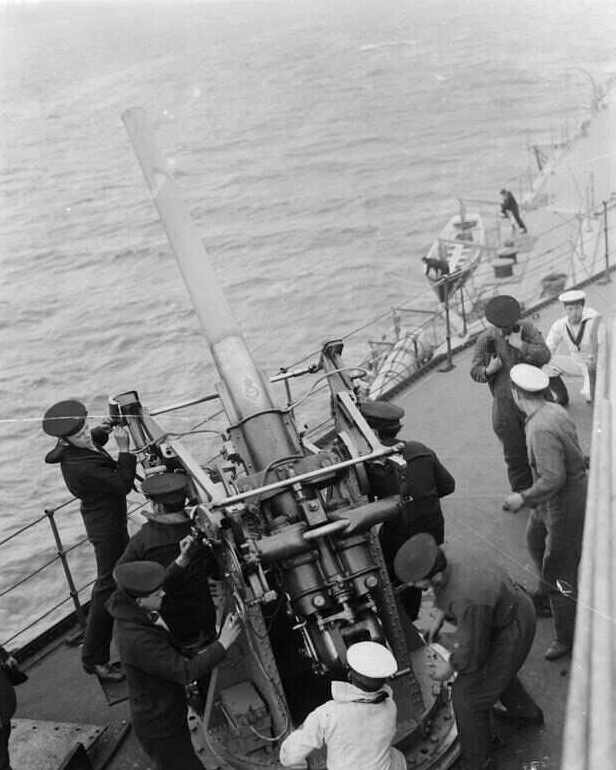The Bransfield class was the culmination of the 'light' cruisers
using the single hull design and adapting it to the differing
armaments from 1905 to 1918. The hull had been easy to produce
and during time of war for the Bransfield and Bjaaland classes
this made it almost 'production line' standards to get the ships
to sea. The final generation of the type took the final step
with the armament going from the mixture of a turret forward
with single mountings aft, to three twin turrets, one forward
and two aft. The simple rangefinder was replaced with a gun
director and 3" AA guns were fitted from new. The 3" replaced
the low angle 4" that had been fitted to previous classes. The
twin 18" torpedoes were upgraded to triple 21" mountings, the
rangefinder controller for these was mounted on the aft bridge
house..
The size and length of the classes had slowly increased from
3,900 tons and 436 feet, to, 4,500 tons and 454 feet. The last
increase in length was made to enlarge the size of the fuel
tanks to increase the range by20%. None of the class was lost
during the World War One. With the completion of the Gerlache
class in 1923, the class was split into three with a Gerlache
and four Bjaaland ships to make up a squadron. 1937 and the
class was slowly refitted to become AA cruisers. The old, slow
firing, 6" weapons being replaced with modern dual purpose 5".
The three turrets being replaced on a one for one basis.
Originally the ships had been armed with 2 pounder AA guns and
20mm for the light AA armament. This was replaced with a uniform
armament of 40mm weapons from 1942. The single 3" had been
replaced by the quad 2 pounder mountings.
Later destroyers had the same 6x5" armament, but had only half
the 40mm fitted to these ships. Where the space of the light
cruiser counted. Antarctica started the war with all twelve of
these ships in service. Two were lost in the first six weeks.
Antarctica, mistakenly, thought that it would be possible to
blockade the enemy submarines in their ports. Aircraft carriers,
battleships, cruisers and destroyers were deployed on this duty.
Land aircraft and submarines sank one aircraft carrier, crippled
a battleship, sank three cruisers and two destroyers before the
fleet was withdrawn. An expensive lesson, never to be repeated.
The only thing achieved during this time was the sinking of two
submarine depot ships, two submarines (alongside the depot
ships) and some miscellaneous vessels in the harbour. A
resounding defeat. The idea had been that the aircraft from the
carriers would be able to protect the fleet from the land
aircraft, detect the submarines and vector the destroyers onto
the submarines. There the destroyers would detect the submarine
with Asdic and sink it with depth charges. What actually
happened was that the land aircraft overwhelmed the fleets
aircraft which were unable to run the ASW missions. The
submarines broke through the destroyer formation with only a
50/50 chance of detection when the submarines then had a field
day firing torpedoes at the fleet. The two Bjaaland class
cruisers were lost putting themselves in front of shoals of
torpedoes meant for the carrier behind them. The remaining ten
ships went to escort Command and took their turns being paired
with the McLintock class escort carriers and fighting the
convoys through. 1943 and the submarines instituted a new tactic
- get the escorts first. Three of the class were lost - going
down by the stern, having had their sterns blown off by the new
acoustic torpedo.
| Displacement | 4,500 tons standard, 5,000 tons full load | |
| Length | 454 ft | |
| Breadth | 46 ft | |
| Draught | 17 ft | |
| Machinery | 4 shaft, steam turbines, 40,000ihp | |
| Speed | 30 knots | |
| Range | 6,000 miles at 10 knots | |
| Armour | 3" side, 2" deck | |
| Armament | As completed 6 x 6" (3x2) 3 x 3" AA (3x1) 4 x 2pd AA (4x1) |
Refits to 1942 6 x 5" (3x2) 16 x 40mm (2x4, 4x2) |
| Torpedoes | 6 x 21" (2x3) | nil (removed 1942) |
| Complement | 455 | 477 |
| Notes | Brigadier Bjaaland - Colonel Hayward - Lieutenant Lodge - Senator Townshend - Brigadier Bachman - Colonel Cummings - Brigadier Bowie - Colonel Carpenter - Major Joel - General Godley - Colonel Creme - Sergeant Major Gouldman - |
|
3" AA gun used on most ships as the AA weapon in WW1.
